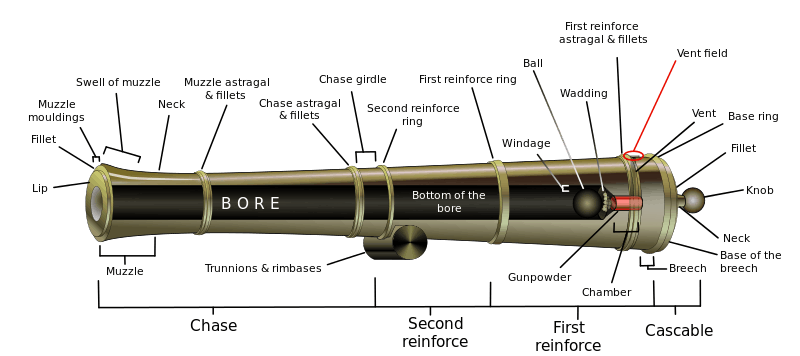Touch hole
A touch hole, also called a vent, is a small hole near the rear portion (breech) of a cannon or muzzleloading gun—that is, the part where the combustion of the powder charge occurs, at the end opposite from the muzzle from which the projectile is fired from the barrel. The vent is the access point through which the propellant charge is ignited. In small arms, the flash from a charge of priming held in the flash pan is enough to ignite the charge within.[1] In artillery, priming powder, a fuse, squib, or friction igniter is inserted into the touch hole to ensure ignition of the charge.

The powder in the touch hole was lit either with a slow match, a linstock or a type of flintlock mechanism that was known as a gunlock.
Spiking the guns
Spiking a gun was a method of temporarily disabling a cannon by hammering a barbed steel spike into the touch-hole; this could be removed only with great difficulty. If a special spike was unavailable, spiking could be done by driving a bayonet into the touch-hole and breaking it off, to leave the blade's tip embedded.[2] Guns could also be rendered useless by burning their wooden carriages or blowing off their trunnions.[3]
Count Friedrich Wilhelm von Bismarck, in his Lectures on the Tactics of Cavalry, recommended that every cavalry soldier carry the equipment needed to spike guns if an encounter with enemy artillery was expected.[4] If a cannon was in danger of being captured by the enemy, its crew would spike the gun to prevent it from being used against them. Captured guns would be spiked if they could not be hauled away and the gun's recapture seemed likely. Covert missions to spike the enemy's guns could also be done to prevent counterattacks and protect ships during withdrawal, as in the case of the Ranger's attack on Whitehaven during the American Revolutionary War.
References
- Vauban and the French military under Louis XIV, Jean-Denis G. G. Lepage, p.38
- Richard M. Lytle (1 January 2004). The Soldiers of America's First Army, 1791. Scarecrow Press. p. 101. ISBN 978-0-8108-5011-8.
- Dewey Lambdin (1 April 2009). H. M. S. Cockerel. McBooks Press. pp. 279–. ISBN 978-1-59013-466-5.
- Bismarck, Friedrich Wilhelm (1855). On the Uses and Application of Cavalry in War. London: T and W Boone. p. viii. Retrieved September 13, 2012., translated by North Ludlow Beamish